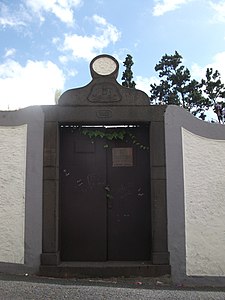
Madeira, officially the Autonomous Region of Madeira, is one of two autonomous regions of Portugal, the other being the Azores. It is an archipelago situated in the North Atlantic Ocean, in a region known as Macaronesia, just under 400 kilometres (250 mi) to the north of the Canary Islands and 520 kilometres (320 mi) west of the Kingdom of Morocco. Madeira is geologically located on the African Tectonic Plate, although it is culturally, politically and ethnically associated with Europe, with its population predominantly descended from original Portuguese settlers. Its population was 251,060 in 2021. The capital of Madeira is Funchal, which is located on the main island's south coast.

Funchal is the largest city, the municipal seat and the capital of Portugal's Autonomous Region of Madeira, bordered by the Atlantic Ocean. The city has a population of 105,795, making it the sixth largest city in Portugal. Because of its high cultural and historical value, Funchal is one of Portugal's main tourist attractions; it is also popular as a destination for New Year's Eve, and it is the leading Portuguese port on cruise liner dockings.

Santa Maria Maior is a civil parish in the eastern part of the municipality of Funchal on the island of Madeira. The population in 2011 was 13,352, in an area of 4.86 km2.

João Gonçalves Zarco is a Portuguese explorer who established settlements and recognition of the Madeira Islands, and was appointed first captain of Funchal by Henry the Navigator.

Bevis Marks Synagogue, officially Qahal Kadosh Sha'ar ha-Shamayim, is the oldest synagogue in the United Kingdom in continuous use. It is located off Bevis Marks, Aldgate, in the City of London.

The history of the Jews in Portugal reaches back over two thousand years and is directly related to Sephardi history, a Jewish ethnic division that represents communities that originated in the Iberian Peninsula.

The history of Madeira begins with the discovery of the islands by Portugal in 1419. There is no record of anyone living on the islands at that time. Portugal began populating the island in 1420.
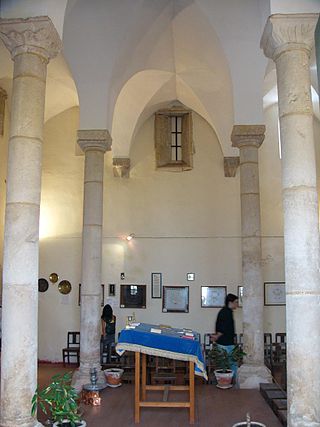
The Synagogue of Tomar is a well-preserved medieval synagogue in Tomar, Portugal. Along with the Synagogue of Castelo de Vide, it is one of two existing pre-expulsion synagogues in the country. It is located at 73 Rua Dr. Joaquim Jaquinto in Tomar's historic city center. Built in the mid-1400s, the building was active as a synagogue only until 1496, when Jews were expelled from Portugal. It now houses the Abraham Zacuto Portuguese Jewish Museum.
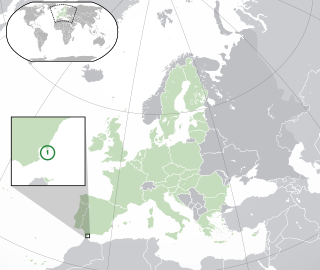
The history of the Jews in Gibraltar dates back more than 650 years. There have been periods of persecution, but for the most part the Jews of Gibraltar have prospered and been one of the largest religious minorities in the city, where they have made contributions to the culture, defence, and Government of Gibraltar.

The British Government's decision to enforce a mass evacuation of the civilian population during the Second World War from the Crown colony of Gibraltar, in order to increase the strength of The Rock with more British Armed Forces personnel, meant that most Gibraltarians were forced to be away from Gibraltar and did not have a place they considered to be home. Only those civilians with essential jobs were allowed to stay. However, this event gave the entire community a heightened sense of "Britishness" by sharing in the war effort.

The Kadoorie Mekor Haim Synagogue is a synagogue of the Jewish community of Porto, situated in the civil parish of Lordelo do Ouro e Massarelos, the municipality of Porto, in the Portuguese northern district of Porto. Constructed along the Rua Guerra Junqueiro beginning in 1929 and inaugurated in 1938, it is the largest synagogue in the Iberian Peninsula.
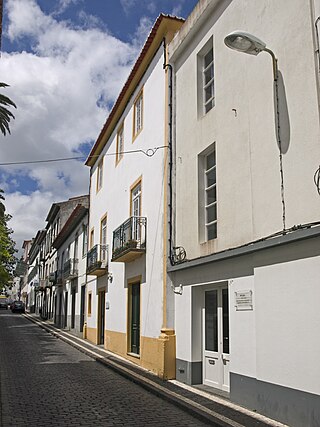
Sahar Hassamain Synagogue is the oldest synagogue in Portugal, built after the expulsion of Jews from the Iberian peninsula.
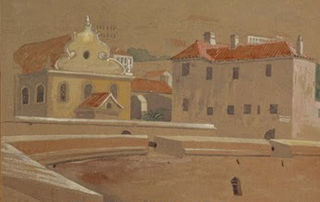
The four active synagogues of Gibraltar are colloquially known as the Great Synagogue, the Little Synagogue, the Flemish Synagogue, and the Abudarham Synagogue. The first synagogue established after the 1717 expulsion of Jews from Gibraltar, the Great Synagogue, was built on what is now known as Engineer Lane, and remains Gibraltar's principal synagogue. The Little Synagogue, founded in 1759 in Irish Town, was the result of the desire of Moroccan Jews for a less formal service. The lavish Flemish Synagogue was built at the turn of the nineteenth century on Line Wall Road, due to the request of some congregants for a return to more formal, Dutch customs. The last synagogue to be established in what is now the British overseas territory of Gibraltar, the Abudarham Synagogue, was founded in 1820 on Parliament Lane by recent Moroccan immigrants.
Jews' Gate Cemetery is a Jewish cemetery located on Windmill Hill within a nature reserve in the British Overseas Territory of Gibraltar. Also known as the Windmill Hill Cemetery, it is the site of the earliest known Jewish burials in Gibraltar. The cemetery opened by 1746 and closed in 1848. It is the burial site of a number of Gibraltar's Chief Rabbis. The graveyard is protected by the law of Gibraltar.
Solomon Abudarham was Chief Rabbi of the British Overseas Territory of Gibraltar until his death from yellow fever in December 1804. Also known as Shelomo Abudarham II, the rabbi established a school of religious study on Parliament Lane and laid the inaugural stone for the Flemish Synagogue on Line Wall Road. In 1820, his academy was converted into the Abudarham Synagogue, named after the rabbi.
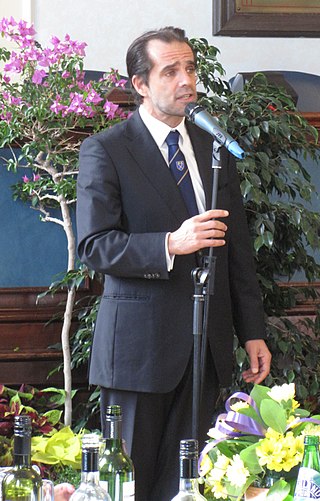
Miguel Filipe Machado de Albuquerque is a Portuguese politician of the Social Democratic Party (PSD) and the current President of the Regional Government of Madeira. He took office as leader of the PSD of Madeira on 10 January 2015. He was a former mayor of Funchal, Madeira. Albuquerque likes gardening, growing many types of roses in his Duchess of Braganza Rose Garden and the Quinta do Arco.

The Building at 33 Rua do Carmo is an historical building located at 33 Rua do Carmo, Funchal, Madeira. It has been suggested that it could have been projected to be a synagogue.

The history of the Jews in Madeira spans the entire length of the history of Madeira itself. The history of Madeira begins with the discovery of the islands by Portugal in 1419. Madeira is presently officially the Autonomous Region of Madeira, and is one of the two autonomous regions of Portugal. It is an archipelago situated in the north Atlantic Ocean, southwest of Portugal. Its total population was estimated in 2016 at 289,000. The capital of Madeira is Funchal, which is located on the main island's south coast.
The following is a timeline of the history of the city of Funchal, Madeira, Portugal.
Abraham Levy was an English Orthodox rabbi, theologian, and author. He served as spiritual head of the Spanish and Portuguese Jewish community in Britain from 1962 to 2012, and was a founding member of Naima Jewish Preparatory School. Levy was appointed an Officer of the Order of the British Empire (OBE) for services on inter-faith co-operation in the 2004 New Year Honours.
